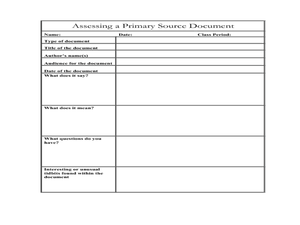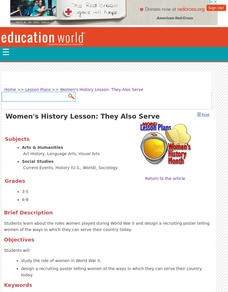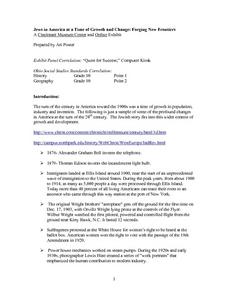Curated OER
Feminism Does Not Have to be an F-Word
Students analyze social activism messages in music. In this feminism lesson, students explore selected music that expresses sentiments voiced in the women liberation movement in the United States. Students compare the lyrics of the songs...
Curated OER
Social Effects of WWII on SC
Fourth graders compare how the events in the Charleston Harbor affected South Carolinians versus people in other parts of the U.S. In this American history lesson, 4th graders watch a video clip, discuss sections of a book, and conduct...
Curated OER
A New Society Project
Ninth graders examine the social and political movements of the Gilded Age and Progressive Era. In this American history lesson, 9th graders work in groups to form their own society and laws. Students make a diagram of their town and...
Curated OER
Segregation: From Jim Crow to Linda Brown
Young scholars examine the African American social, economic, and political conditions between 1896 and 1953. In this segregation lesson, students analyze primary sources to develop an understanding of the plight of African Americans'...
Curated OER
Lewis and Clark: Meeting the Indians of the Northwest
Eighth graders examine the relationships forged with Native Americans by Lewis and Clark. In this Westward Expansion lesson, 8th graders research digital and print sources to study details regarding the Native American tribes that Lewis...
Curated OER
The Defeat of the ERA
Eleventh graders take a closer look at the Equal Rights Amendment (ERA). In this women's rights lesson, 11th graders read the Equal Rights Amendment as well as the "Feminine Mystique" and selections by Gloria Steinam and Phyllis...
Curated OER
West Virginia State Museum Lesson Plan: West Virginia Music
Students compare and contrast music about West Virginia. In this West Virginia history lesson, students analyze popular music so that they may gain an understanding of the relationships between songs and history. Students then create...
Curated OER
Roswell and the Civil War
Students consider the impact of the American Civil War on Georgia. In this Georgia history lesson, students discover Roswell's contributions to the Confederate effort and then create children's books that illustrate the destruction of...
Curated OER
The People of Kansas: Who Are They and Why Are They Here?
Students examine the settlement patterns of the Kansas Territory. In this Kansas history lesson, students analyze primary documents from the pioneers in the territory. Students write letters or perform skits that feature their findings.
Curated OER
Elders as Resources
Students participate in an oral history project where they interview a person's valuable insights to their life stories. They gain personal experience in an interactive process that brings history alive all over again. Students conduct...
Curated OER
Past Presence
Learners examine British Black History. In this current events lesson, students visit selected websites to research the history of Blacks in Great Britain. Several lesson enhancement ideas are included.
Curated OER
They Also Serve
Learners explore the roles women played during World War II. They design a recruiting poster telling women of the ways in which they can serve their country today and present their posters to the class.
Curated OER
Elizabeth Cady Stanton, Suffragist
Young scholars examine one woman's impact on a nation. For this suffragette lesson, students are introduced to Elizabeth Cady Stanton and examine her involvement in both the anti-slavery and woman's movement. Young scholars compare the...
Curated OER
Jews in America at the Time of Growth and Change: Forging New Frontiers
Tenth graders examine the role of Jewish Americans in the 1900s. They examing the changes in industry and inventions. They also identify how Jewish Americans changed society and religious organization.
National Woman's History Museum
Stacey Abrams: Changing the Trajectory of Protecting People’s Voices and Votes
In this project-based learning lesson, young social scientists investigate Stacey Abrams' campaign to protect the voting rights of people across the nation. Investigators learn how to annotate assigned articles, watch videos, and collect...
Curated OER
Focused Learning Lesson: American History
Eleventh graders examine the 1920s which was known as the "Roaring Twenties". They identify the Harlem Renaissance, Prohibition, and the Women's Suffrage movement.
Curated OER
Views of the American West: True or False?
Young scholars explain that a landscape painting may or may not accurately represent a specific place. They identify techniques that create the illusion of three-dimensional space on a flat surface.
Curated OER
Women in History: Jacqueline Bouvier Kennedy Onassis
In this women in history worksheet, students read a biography of Jacqueline Bouvier Kennedy Onassis. Students then answer 6 multiple choice questions and 1 essay question about the passage.
Curated OER
Focused Learning Lesson: American History
Eleventh graders review the Progressive Movement and the Women's suffrage movement. They also review the changes from the end of World War I to the Great Depression.
Curated OER
WHERE ARE THE FAMOUS WOMEN IN HISTORY?
Students list/compare the number of men in history they can think of to the number of famous women. They discuss why there are more men than women on the list. They examine their textbooks for the same comparison and discuss the results.
Curated OER
Women in Baseball:Talk Show
Students explore the development of women's baseball during the 20th century. They "role play" women who participated in some form of baseball (amateur, semi-professional, or professional) as well as other advocates of women's sports as...
Curated OER
National Congress of Neighborhood Women
Students research and create a case study as an illustration of the different programs created by the National Congress of Neighborhood Women. Then they present their cases to the class and discuss.
Curated OER
The United Nations and Women
Students analyze the role of the Commission on the Status of Women in the post-WW II era by looking at the general framework the Committee worked within. They propose their own solutions to the case studies.

























